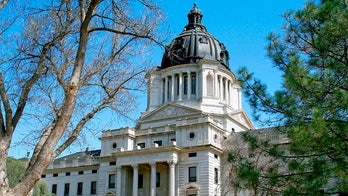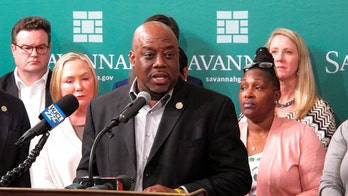
FILE: A doctor treats a patient at his office in Peoria, Illinois. (REUTERS)
“Stick a fork in it. It’s finally done,” exclaimed House Energy and Commerce Committee Chairman Rep. Fred Upton, R-Mich., in a news release.
Congress this week finally put to bed one of the most vexing issues to confound lawmakers in recent years: the dreaded “doc fix.”
The doc fix is a formula the government uses to pay physicians who treat patients on Medicare. The federal government reimburses doctors for accepting seniors on Medicare. People on Medicare pay less than they would otherwise for medical services. The government makes up the difference and pays the doctors. But even after that plan, there was a chasm due to inflation. Congress kept approving Band-Aid’s to fill the gap. Expensive ones, too.
The latest stopgap was about to expire. If Congress didn’t act soon, physicians would face a 21 percent cut in their payments from Washington when caring for those who use Medicare.
If doctors weren’t getting paid, they weren’t going to treat Medicare patients. That could have created a major public health issue.
Health care is expensive. That’s why a fight over ObamaCare lingers to this day. But the role of government in diminishing the cost of health care (through programs such as Medicare and Medicaid) and the national debt crystallized in the debate over the doc fix. It epitomized why Washington struggles to get a grasp on spending.
It’s no surprise that it took a bipartisan deal negotiated at the very top to finish off the doc fix once and for all. House Speaker John Boehner, R-Ohio, and House Minority Leader Nancy Pelosi, D-Calif., developed a new system to pay doctors and abandon the antiquated pay schedule that was nothing more than a patch.
The House OK’d the new plan in late March, 392-37. The Senate followed late Wednesday night, 92-8.
One would think that if both houses of Congress adopted the new plan with such robust, bipartisan, super-majorities, there wouldn’t be a problem, right?
Hardly.
Some conservative lawmakers abhorred the new plan and voted nay. The total price tag of the doc fix was more than $200 billion. Only about $60 to $70 billion was offset, which triggered $140 billion of extra deficit spending.
That’s the conundrum that eluded lawmakers for so long on the doc fix. Nobody wants to add such a prodigious chunk of change to deficit spending -- especially fiscal conservatives. But it’s political suicide to cut off seniors from their doctors, too.
Rep. Michael Burgess, R-Texas, a physician by trade who’s worked on the doc fix for years, argued that repeated patches were more expensive than the bipartisan compromise -- which was still not cheap.
“What’s the cost of doing nothing? A billion dollars more than what we’re doing today” Burgess said. “If you don’t fix this formula, you almost can’t move on. This is the first step in that process. Perfect? No. A good step? Yes.”
Conservative groups lambasted the plan as “budget gimmickry” and “fake” spending cuts. They asserted that what doctors are due over the next decade when they treat Medicare patients is about $30 billion above what the Congressional Budget Office anticipates. Some of that’s because they believe the fee schedule for various medical treatments is unrealistic and the costs will multiply.
Naturally, Sen. Ted Cruz, R-Texas, and other conservatives balked at the $200 billion price tag.
The deadline for approving a new doc fix was really April 1. The House finished up well before then. But the Senate was wrestling with adopting a budget. Senators debated and voted well into the wee hours of the morning of March 27 before leaving for a two-week break for Passover and Easter once completing the budget. There was some speculation the Senate may try to handle the doc fix just before dawn that morning. But leaders knew conservatives had major reservations about such a gambit. They didn’t want to face criticism that they “rammed through” such a controversial plan in the dark of night.
After all, Senate Majority Leader Mitch McConnell, R-Ky., promised an open, thoughtful amendment process when he seized the helm. Pushing through the doc fix at that hour would have diminished that commitment.
So the doc fix sat. And sat. And sat. Right up until the night of April 15. Everyone on Capitol Hill knew that payment reductions to doctors started on April 16th. That’s when the government began writing checks to physicians. If Congress hadn’t acted by then, the government would cut smaller checks.
There was talk about amending the plan in the Senate and shipping it back to the House.
“We all knew the Perils of Pauline that the raft was going over the waterfall,” protested an exasperated Burgess about his Senate colleagues.
Washington Democratic Rep. Jim McDermott, a psychiatrist who also toiled on the doc fix, upbraided conservatives who didn’t like the new proposal.
“The Republicans keep wanting people to believe you can have things without paying for them,” McDermott said. “If they want to pull the medical profession and the public through the rat hole, that’s their privilege.”
Cruz and others pushed to have all of the costs offset. That failed. In an effort to court the votes of skeptics, Senate Majority Whip John Cornyn, R-Texas, authored an amendment to offset the unpaid portion of the new doc fix plan. Cornyn would make up the difference by using money saved by eliminating the ObamaCare mandate that requires everyone to purchase health coverage. That effort plummeted on the floor, too.
On Wednesday night, the Senate lugged the bill to passage in what proved to be a rare bipartisan moment.
“I want to thank Leader Pelosi for her indispensable leadership,” said Boehner on Thursday morning at a Capitol Hill ceremony to send the legislation to the White House.
“When the American people choose divided government, they’re not saying they don't want anything done,” McConnell said.
While lawmakers managed to extinguish the flames of one lone, smoldering blaze -- even while heaping on some additional deficit spending, they all knew this was nothing compared to the other challenges Congress faces with the books.
“We have a lot more work to do to fix these entitlement programs,” Boehner offered.
And when does Congress intend to start fixing entitlement programs like Medicare, Medicaid and Social Security, the largest drivers of the debt? Well, there hasn’t been a really big effort on this front since the altercation over raising the debt ceiling in 2011. Those negotiations failed. Congress then empaneled what was called the “supercommittee,” a bipartisan, bicameral group of lawmakers to engineer major cuts. The supercommittee failed, too.
In fiscal 2013, the federal government spent a grand total of $3.4 trillion for all programs. Just over $2 trillion of that went toward entitlement programs such as Medicare, Medicaid and Social Security -- and some service on the national debt. Entitlement programs are the biggest drivers of federal spending and the national debt. So what is Congress left to do? There are basically three options:
Lawmakers could raise taxes. That is a non-starter in a Republican-controlled Congress.
Lawmakers could cut benefits. That is a non-starter in almost any Congress. Seniors who receive those entitlement programs vote. Atop the Capitol in Washington, construction workers are refurbishing the Dome. If Congress slashed entitlement programs, members of the public would likely storm the Capitol, doing so much damage that they’d have to start the Dome project all over again.
Lawmakers could cover the cost of entitlement programs by cutting spending elsewhere. The idea sounds good. But a set of mandatory spending cuts, known as sequestration (set in motion automatically by the failure of the supercommittee) has already nicked federal spending down to the bone. There’s not a lot of other fat out there to cut. And besides, entitlement spending outpaces all other spending 2:1. So there’s not even a way to make up the difference because the non-entitlement spending pot is half the size of the entitlement pot.
This is why it’s a near-impossible task for Congress to reduce overall federal spending and harness the national debt. Conservatives came to Washington with the promise to reduce federal spending. Well, they can, and have -- on everything but the items that explode the debt the most.
The challenge to solve the doc fix was a microcosm of a riddle. How do lawmakers cut yet maintain benefits? It’s almost an expression in a Zen-like koan – the enigmatic realization of two phenomena that are opposite one another. Like being tense but flexible. Controlled but free. Exerting effortless effort. A sour sweetness. A bankrupt wealth. Things that don’t align – except in the world of Zen and Taoism.
This is the quandary facing Congress when it comes to spending. And it may take a Zen-like effort to figure it all out.




